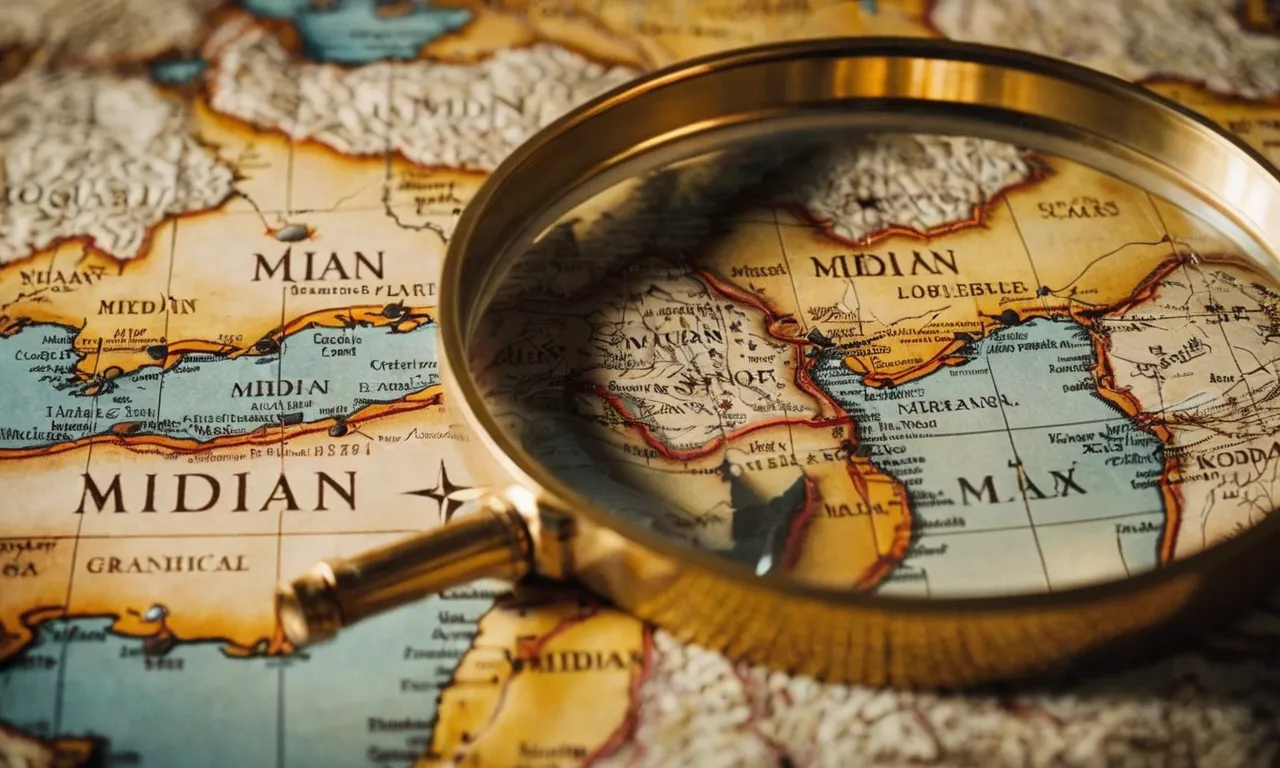Where Is Midian In The Bible? A Detailed Look At The Biblical Region
The mysterious land of Midian is mentioned numerous times throughout the Bible, playing an important role in the life of Moses and the Israelites.
But where exactly was the land of Midian located? In this comprehensive article, we will examine the biblical clues about the location of Midian and explore its significance in biblical history.
If you’re short on time, here’s a quick answer to your question: Most scholars believe Midian was located in the northwestern Arabian Peninsula, likely in modern-day northwest Saudi Arabia and southern Jordan and Palestine.
Introducing Midian in the Bible
First Biblical Mentions
The region of Midian first appears in the biblical book of Genesis when Joseph was sold by his brothers to Midianite merchants traveling towards Egypt (Genesis 37:28, 36). Several references are then made to the Midianites during the Exodus story.
Moses fled to the land of Midian after killing an Egyptian slave master and married Zipporah, the daughter of the Midianite priest Reuel (also called Jethro) (Exodus 2:15-22).
Later, after the burning bush encounter, Moses was instructed by God to “Go back to Egypt for all those who wanted to kill you are dead” (Exodus 4:19).
Before leaving Midian, Moses sought permission from his Midianite father-in-law to return.
Midian as a Region
The land of Midian was located in the northwestern Arabian Peninsula, east of the Gulf of Aqaba, probably overlapping with some parts of present-day northwest Saudi Arabia and southern Jordan.
Biblical and historical records indicate that Midianites were semi nomadic herders who moved through large swaths of this desert wilderness and highlands region along ancient caravan trade routes.
Several places mentioned in the Bible provide clues about the location of Midian. After fleeing Egypt, Moses came to “the far side of the wilderness” and “the mountain of God” called Horeb (Exodus 3:1), likely the modern Jabal al-Lawz mountain range in northwest Saudi Arabia.
Later, the Israelites battled and defeated the Midianites in “the plains of Moab by the Jordan across from Jericho” (Numbers 22:1), placing Midian east of the Dead Sea and Jordan River.
Thus, Midian seems to have encompassed a large territory along desert trade routes of the northern Arabian Peninsula.
The Midianites as a People Group
The Bible refers to “Midianites” as a distinct people group, descended from Midian, one of the six sons of Abraham and his wife Keturah (Genesis 25:1-2). This means they were distant relatives of the Israelites.
The Midianites were first described as traveling merchants buying and selling goods across the deserts (Genesis 37:28).
Later, when Moses was living in Midian, the priest of Midian, Reuel (Jethro) was described as having seven daughters who came to draw water for their father’s flocks (Exodus 2:16-17).
This offers a glimpse into the semi nomadic lives of Midianites as herders raising livestock across the wilderness.
At times, the Midianites interacted with Israelites in conflict. For example, the Israelites “went to war against Midian” after the women of Midian seduced the Israelite men into idolatry (Numbers 31:1-3).
However, the Midianites could also constructively engage with Israelites, as Moses’ Midianite wife and father-in-law supported his leadership and return to Egypt.
Biblical Clues About the Location of Midian
References to Geography
The Bible contains several geographical references that provide clues as to where the land of Midian was located. Exodus describes the Midianites living near the border of the Wilderness of Sinai and worshipping a mountain god (Exodus 3:1).
This would place Midian in close proximity to Mount Sinai itself.
In Numbers 10:12, the Israelites set out from the Wilderness of Sinai to travel to the Wilderness of Paran, which was located in the northern Sinai peninsula.
Along the way, they passed through Hazeroth, where Moses’ brother-in-law Hobab was from the land of Midian (Numbers 10:29).
This reference also puts Midian north of the traditional site of Mount Sinai.
Proximity to Mt. Sinai
As the passages in Exodus 3 and Numbers 10 show, the land of Midian was located near Mount Sinai. In fact, it was when Moses was living with Jethro, the priest of Midian, that God first revealed himself to Moses in the burning bush and called Moses to lead the Israelites out of Egypt (Exodus 3:1-12).
Midian had to be close enough for Moses to return after this meeting to lead the Israelites towards Canaan.
Archaeologist James Hoffmeier claims the Midianites occupied territory on both sides of the Gulf of Aqaba, placing them directly east of Mount Sinai.
This would allow for easy passage between Midian and the wilderness wandering locations of the Israelites.

The Significance of Midian in Key Biblical Events
Moses in Midian
After fleeing Egypt for killing an Egyptian taskmaster, Moses ended up in the land of Midian. He met Reuel (also called Jethro), the priest of Midian, whose daughter Zipporah he later married.
Moses worked as a shepherd for his father-in-law for 40 years in Midian (Exodus 2:11-22).
This was a key period in Moses’ life where God prepared him for his future leadership role in delivering the Israelites from slavery in Egypt. The simple life as a shepherd humbled Moses and molded him into a more patient, faithful man.
Midian provided a place of refuge for Moses to escape from Pharaoh.
The Midianites as Rivals and Enemies
Later in the Exodus story, the Midianites joined with the Moabites in hiring Balaam to curse the Israelites, revealing their opposition to God’s people (Numbers 22).
As rivals, the Midianites used their women to seduce Israelite men into idolatry and sexual immorality (Numbers 25:1-18).
This resulted in a plague that killed 24,000 Israelites. Consequently, the Lord ordered Moses to take vengeance on Midian, and 12,000 Israelites attacked them and killed all their men, including the five kings of Midian (Numbers 31).
Throughout the period of the Judges, the Midianites repeatedly invaded Israel and ravaged their produce and livestock (Judges 6-7).
God raised up Gideon to defeat their powerful army with just 300 men. This displayed God’s power and Israel’s dependence on Him for victory against enemies like Midian.
Midianite Religion and Gods
Archaeological evidence reveals that the Midianites worshiped many gods. When Moses stayed in Midian, the priest Reuel served multiple gods (Exodus 18:11-12).
The Midianites later introduced idolatry involving Baal to Israel that God considered detestable (Numbers 25:1-2, Deuteronomy 4:3).
In Judges 8:24-26, Gideon made an ephod out of the gold won from the Midianites that later became an idol, indicating the influence of Midianite religious practices and images.
The Legacy of Midian Today
Biblical Sites in Modern Midian
Although the Midianites faded from prominence after biblical times, traces of their civilization can still be found today in the region of Midian, located in northwestern Saudi Arabia along the eastern shore of the Gulf of Aqaba.
Several important biblical sites associated with the Midianites have been identified by archaeologists in modern-day Midian.
One of the most significant is the archaeological site of Madyan, which is believed to be the same place the Bible refers to as Midian.
Excavations at Madyan have uncovered the remains of an ancient city that thrived during the first millennium BC when the Midianites inhabited the region.
Impressive ruins of temples, homes, and other buildings point to Madyan as an important center of trade and religion for the Midianites.
Another important Midianite site is Jabal al-Lawz, a mountain located just east of Madyan. According to local tradition, Jabal al-Lawz is the biblical Mount Sinai where Moses received the Ten Commandments.
Archaeological evidence shows this mountain was a major cultic center for the ancient Midianites, with pilgrimage trails and offerings found on its slopes.
While its identification as Mount Sinai remains disputed, Jabal al-Lawz sheds light on the spiritual practices of the Midianites.
Descendants of the Midianites
While the Midianites faded from the historical record after biblical times, some scholars believe their descendants may be found among the modern-day Bedouin tribes inhabiting the Midian region of Saudi Arabia.
These nomadic tribes share similarities in culture and language with their Midianite predecessors. For example, the Huwaitat Bedouins utilize a distinctive dialect of Arabic with ancient poetic styles reminiscent of Midianite oral traditions mentioned in the Bible.
Additionally, the traditional nomadic lifestyle of herding sheep and goats persists among Midianite Bedouin descendants to this day.
However, the linkage between modern Bedouin tribes and the ancient Midianites remains speculative. More research on the customs, oral histories, and genetic makeup of Northwestern Saudi Arabian tribes may shed further light on this connection.
Regardless, the traces of Midianite language and culture evident among Bedouin groups hint at the legacy these ancient people left behind in their ancestral homeland.
Conclusion
The land of Midian remains an intriguing biblical locale, playing a pivotal role across Old Testament stories. While its exact boundaries are still debated, ancient and archaeological evidence point to Midian occupying the northwest corner of the Arabian Peninsula.
Beyond geography, Midian left an indelible mark on biblical history through Moses’ sojourn there and the enduring conflict between the Israelites and Midianites.
The biblical Midianites remind us how Old Testament events connected disparate groups across the ancient Middle East.






